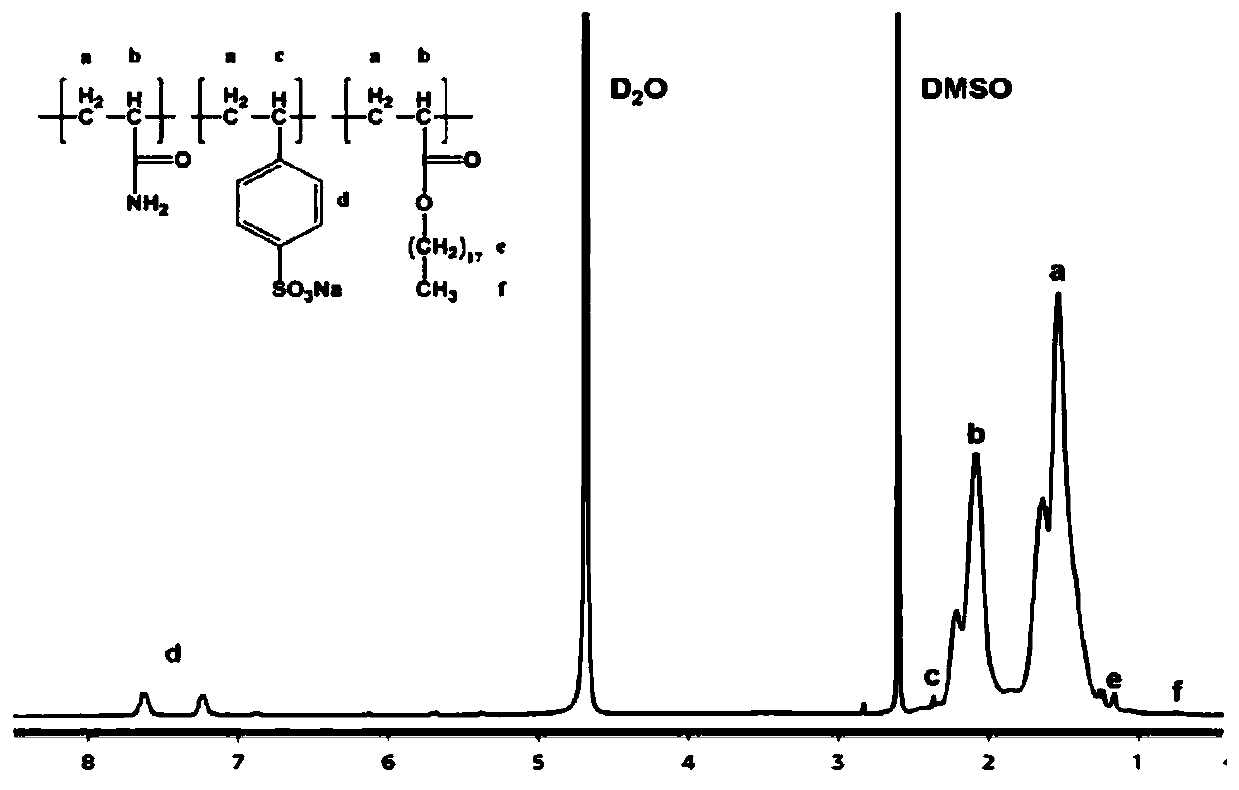A self-demulsifying heavy oil viscosity reducer and its preparation method and application
A heavy oil viscosity reducer and demulsification technology, applied in chemical instruments and methods, earthwork drilling, wellbore/well components, etc. Molecular weight decline and other problems, to achieve the effect of simple and easy synthesis method, improved oil recovery rate, and large molecular weight
- Summary
- Abstract
- Description
- Claims
- Application Information
AI Technical Summary
Problems solved by technology
Method used
Image
Examples
Embodiment 1
[0062] A self-demulsifying heavy oil viscosity reducer, which is obtained by copolymerizing the following monomers:
[0063] Acrylamide 97.8 mol%
[0064] Sodium p-styrene sulfonate 2 mol%
[0065] Octadecyl acrylate 0.2 mol%.
[0066] The preparation method of the above-mentioned self-demulsifying heavy oil viscosity reducer comprises steps:
[0067] (1) Weigh 13.90g of acrylamide, 0.82g of sodium p-styrenesulfonate and 0.13g of stearyl acrylate into a container, add 66.20mL of dimethyl sulfoxide, stir at 50°C for 5min, and wait until the raw materials are completely Dissolve; after the raw material is completely dissolved, inject nitrogen gas, stir at 50°C for 30 minutes, and make it completely in the nitrogen atmosphere to obtain the raw material solution;
[0068] (2) Under nitrogen atmosphere, heat up to 70°C, then add 0.0743g of initiator azobisisobutyronitrile, and react for 7h at 70°C under nitrogen protection; after the reaction, the product is precipitated and was...
Embodiment 2
[0085] A self-demulsifying heavy oil viscosity reducer, which is obtained by copolymerizing the following monomers:
[0086] Acrylamide 97.6 mol%
[0087] Sodium p-styrene sulfonate 2 mol%
[0088] Octadecyl Acrylate 0.4 mol%.
[0089] The preparation method of the above-mentioned self-demulsifying heavy oil viscosity reducer comprises steps:
[0090] (1) Weigh 13.87g of acrylamide, 0.82g of sodium p-styrene sulfonate and 0.26g of stearyl acrylate into a container, add 66.20mL of dimethyl sulfoxide, stir at 50°C for 5min, and wait until the raw materials are completely Dissolve; after the raw material is completely dissolved, inject nitrogen gas, stir at 50°C for 30 minutes, and make it completely in the nitrogen atmosphere to obtain the raw material solution;
[0091] (2) Under nitrogen atmosphere, heat up to 70°C, then add 0.0747g of initiator azobisisobutyronitrile, and react for 7h at 70°C under nitrogen protection; after the reaction, precipitate and wash the product w...
Embodiment 3
[0107] A self-demulsifying heavy oil viscosity reducer, which is obtained by copolymerizing the following monomers:
[0108] Acrylamide 97.5 mol%
[0109] Sodium p-styrene sulfonate 2 mol%
[0110] Octadecyl acrylate 0.5 mol%.
[0111] The preparation method of the above-mentioned self-demulsifying heavy oil viscosity reducer comprises steps:
[0112] (1) Weigh 13.85g of acrylamide, 0.82g of sodium p-styrenesulfonate and 0.325g of stearyl acrylate into a container, add 66.20mL of dimethyl sulfoxide, stir at 50°C for 5min, and wait until the raw materials are completely Dissolve; after the raw material is completely dissolved, inject nitrogen gas, stir at 50°C for 30 minutes, and make it completely in the nitrogen atmosphere to obtain the raw material solution;
[0113] (2) Under a nitrogen atmosphere, heat up to 70°C, then add 0.0750 g of initiator azobisisobutyronitrile, and react for 7 hours at 70°C under nitrogen protection; after the reaction, the product is precipitated ...
PUM
 Login to View More
Login to View More Abstract
Description
Claims
Application Information
 Login to View More
Login to View More - R&D
- Intellectual Property
- Life Sciences
- Materials
- Tech Scout
- Unparalleled Data Quality
- Higher Quality Content
- 60% Fewer Hallucinations
Browse by: Latest US Patents, China's latest patents, Technical Efficacy Thesaurus, Application Domain, Technology Topic, Popular Technical Reports.
© 2025 PatSnap. All rights reserved.Legal|Privacy policy|Modern Slavery Act Transparency Statement|Sitemap|About US| Contact US: help@patsnap.com



